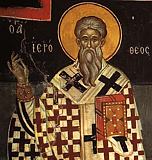 Hieromartyr Hierotheus, bishop of Athens (1st c.).
Hieromartyr Hierotheus, bishop of Athens (1st c.).  Uncovering of the relics (1595) of St. Gurias, first archbishop of Kazan, and St. Barsanuphius, bishop of Tver (1595).
Uncovering of the relics (1595) of St. Gurias, first archbishop of Kazan, and St. Barsanuphius, bishop of Tver (1595).  Synaxis of the Saints of Kazan.
Synaxis of the Saints of Kazan.
Martyrs Gaius, Faustus, Eusebius, and Chaeremon, of Alexandria (3rd c.). Hieromartyr Peter of Capitolia, bishop of Bostra in Arabia (715). Martyrs Domnina and her daughters Berenice (Bernice) and Prosdoce, of Syria (302). Martyr Adauctus (ca. 312) and his daughter St. Callisthene (ca. 318), of Ephesus. Sts. Paul the Simple (ca. 339) and Ammon (350), of Egypt, disciples of St. Anthony the Great. St. Vladimir Yaroslavich, prince of Novgorod (1052), and his mother St. Anna of Novgorod (1050). Sts. Helladius and Onesimus of the Near Caves in Kiev (12th c.-13th c.). St. Ammon, recluse, of the Far Caves in Kiev (13th c.). St. Stephen Stiljanovic, despot of Srem, Serbia (1540) and his wife St. Helen (Elizabeth in monasticism) (ca. 1543). Sts. Jonah and Nectarius, monks, of Kazan (16th c.).
New Hieromartyrs Basil (Tsvetkov), archimandrite, of Stary Kelets (Ryazan) and Tikhon Arkhangelsky, archpriest, of Kuiman (Voronezh) (1937). New Hiero-confessor Barsanuphius (Yurchenko) of Kherson (1954).
St. Theodore the Wonderworker, bishop of Tamassos, Cyprus (2nd c.). Hieromartyr Peter of Capitolia, bishop of Bostra in Arabia (715). St. John (Lampadistes) of Cyprus (10th c.). Hieromartyr Evdemoz, catholicos of Georgia (1642).
Nineteenth Sunday After Pentecost. [II Cor. 11:31-12:9;
Luke 6:31-36]
The fundamental, original commandment
is: love! It is a small word, but it expresses an
all-encompassing thing. It is easy to say: you must love,
but it is not easy to attain love to the necessary degree.
It is also not exactly clear how to attain it; this is why
the Saviour surrounds this commandment with other
explanatory rules: love as thyself; and as ye would
that men should do to you, do ye also to them
likewise. Here is shown a degree of love that one can
call boundless; for is there any limit to one’s love
for oneself? And is there any good which one would not
want for himself from others? Meanwhile, however, the
instructions are not impossible to fulfil. The matter
depends upon having perfect compassion toward others, to
fully transfer their feelings to yourself, to feel the way
they feel. When this occurs, there will be no need to
point out what you must do for others in a given
situation: your heart will show you. You must only take
care to maintain compassion, otherwise egoism will
immediately approach and return you to itself and confine
you in itself. Then you will not lift a finger for
another, and will not look at him, though he might be
dying. When the Lord said: love thy neighbor as
thyself, He meant that our neighbour should be in us,
that is, in our heart, instead of our own selves. If our
“I” remains in there as before, we cannot
expect anything good to come of it.


![]() Hieromartyr Hierotheus, bishop of Athens (1st c.).
Hieromartyr Hierotheus, bishop of Athens (1st c.). ![]() Uncovering of the relics (1595) of St. Gurias, first archbishop of Kazan, and St. Barsanuphius, bishop of Tver (1595).
Uncovering of the relics (1595) of St. Gurias, first archbishop of Kazan, and St. Barsanuphius, bishop of Tver (1595). ![]() Synaxis of the Saints of Kazan.
Synaxis of the Saints of Kazan. 
















